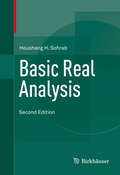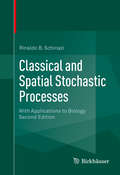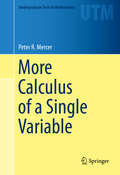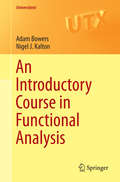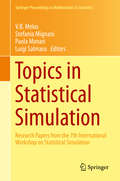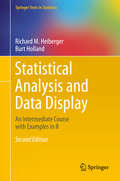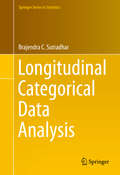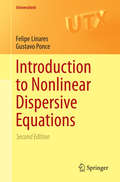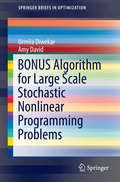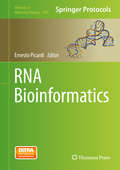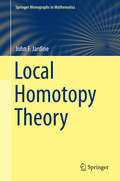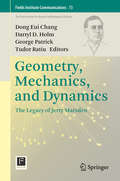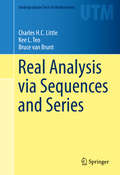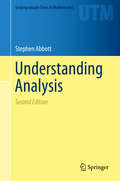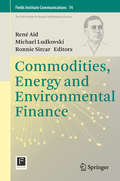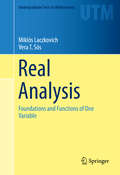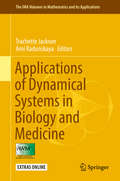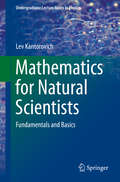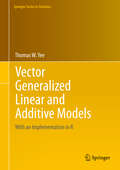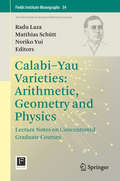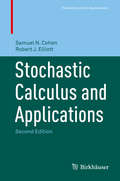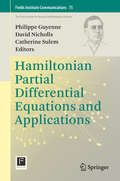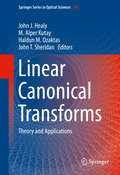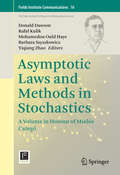- Table View
- List View
Basic Real Analysis
by Houshang H. SohrabThis expanded second edition presents the fundamentals and touchstone results of real analysis in full rigor, but in a style that requires little prior familiarity with proofs or mathematical language. The text is a comprehensive and largely self-contained introduction to the theory of real-valued functions of a real variable. The chapters on Lebesgue measure and integral have been rewritten entirely and greatly improved. They now contain Lebesgue's differentiation theorem as well as his versions of the Fundamental Theorem(s) of Calculus. With expanded chapters, additional problems, and an expansive solutions manual, Basic Real Analysis, Second Edition is ideal for senior undergraduates and first-year graduate students, both as a classroom text and a self-study guide. Reviews of first edition: The book is a clear and well-structured introduction to real analysis aimed at senior undergraduate and beginning graduate students. The prerequisites are few, but a certain mathematical sophistication is required. . . . The text contains carefully worked out examples which contribute motivating and helping to understand the theory. There is also an excellent selection of exercises within the text and problem sections at the end of each chapter. In fact, this textbook can serve as a source of examples and exercises in real analysis. --Zentralblatt MATH The quality of the exposition is good: strong and complete versions of theorems are preferred, and the material is organised so that all the proofs are of easily manageable length; motivational comments are helpful, and there are plenty of illustrative examples. The reader is strongly encouraged to learn by doing: exercises are sprinkled liberally throughout the text and each chapter ends with a set of problems, about 650 in all, some of which are of considerable intrinsic interest. --Mathematical Reviews [This text] introduces upper-division undergraduate or first-year graduate students to real analysis. . . . Problems and exercises abound; an appendix constructs the reals as the Cauchy (sequential) completion of the rationals; references are copious and judiciously chosen; and a detailed index brings up the rear. --CHOICE Reviews
Classical and Spatial Stochastic Processes: With Applications to Biology
by Rinaldo B. SchinaziThe revised and expanded edition of this textbook presents the concepts and applications of random processes with the same illuminating simplicity as its first edition, but with the notable addition of substantial modern material on biological modeling. While still treating many important problems in fields such as engineering and mathematical physics, the book also focuses on the highly relevant topics of cancerous mutations, influenza evolution, drug resistance, and immune response. The models used elegantly apply various classical stochastic models presented earlier in the text, and exercises are included throughout to reinforce essential concepts. The second edition of Classical and Spatial Stochastic Processes is suitable as a textbook for courses in stochastic processes at the advanced-undergraduate and graduate levels, or as a self-study resource for researchers and practitioners in mathematics, engineering, physics, and mathematical biology. Reviews of the first edition: An appetizing textbook for a first course in stochastic processes. It guides the reader in a very clever manner from classical ideas to some of the most interesting modern results. . . . All essential facts are presented with clear proofs, illustrated by beautiful examples. . . . The book is well organized, has informative chapter summaries, and presents interesting exercises. The clear proofs are concentrated at the ends of the chapters making it easy to find the results. The style is a good balance of mathematical rigorosity and user-friendly explanation. --Biometric Journal This small book is well-written and well-organized. . . . Only simple results are treated . . . but at the same time many ideas needed for more complicated cases are hidden and in fact very close. The second part is a really elementary introduction to the area of spatial processes. . . . All sections are easily readable and it is rather tentative for the reviewer to learn them more deeply by organizing a course based on this book. The reader can be really surprised seeing how simple the lectures on these complicated topics can be. At the same time such important questions as phase transitions and their properties for some models and the estimates for certain critical values are discussed rigorously. . . . This is indeed a first course on stochastic processes and also a masterful introduction to some modern chapters of the theory. --Zentralblatt Math
More Calculus of a Single Variable
by Peter R. MercerThis book goes beyond the basics of a first course in calculus to reveal the power and richness of the subject. Standard topics from calculus -- such as the real numbers, differentiation and integration, mean value theorems, the exponential function -- are reviewed and elucidated before digging into a deeper exploration of theory and applications, such as the AGM inequality, convexity, the art of integration, and explicit formulas for π. Further topics and examples are introduced through a plethora of exercises that both challenge and delight the reader. While the reader is thereby exposed to the many threads of calculus, the coherence of the subject is preserved throughout by an emphasis on patterns of development, of proof and argumentation, and of generalization. More Calculus of a Single Variable is suitable as a text for a course in advanced calculus, as a supplementary text for courses in analysis, and for self-study by students, instructors, and, indeed, all connoisseurs of ingenious calculations.
An Introductory Course in Functional Analysis (Universitext)
by Adam Bowers Nigel J. KaltonBased on a graduate course by the celebrated analyst Nigel Kalton, this well-balanced introduction to functional analysis makes clear not only how, but why, the field developed. All major topics belonging to a first course in functional analysis are covered. However, unlike traditional introductions to the subject, Banach spaces are emphasized over Hilbert spaces, and many details are presented in a novel manner, such as the proof of the Hahn-Banach theorem based on an inf-convolution technique, the proof of Schauder's theorem, and the proof of the Milman-Pettis theorem. With the inclusion of many illustrative examples and exercises, An Introductory Course in Functional Analysis equips the reader to apply the theory and to master its subtleties. It is therefore well-suited as a textbook for a one- or two-semester introductory course in functional analysis or as a companion for independent study.
Topics in Statistical Simulation
by Luigi Salmaso Stefania Mignani V. B. Melas Paola MonariThe Department of Statistical Sciences of the University of Bologna in collaboration with the Department of Management and Engineering of the University of Padova, the Department of Statistical Modelling of Saint Petersburg State University, and INFORMS Simulation Society sponsored the Seventh Workshop on Simulation. This international conference was devoted to statistical techniques in stochastic simulation, data collection, analysis of scientific experiments, and studies representing broad areas of interest. The previous workshops took place in St. Petersburg, Russia in 1994, 1996, 1998, 2001, 2005, and 2009. The Seventh Workshop took place in the Rimini Campus of the University of Bologna, which is in Rimini's historical center.
Statistical Analysis and Data Display
by Richard M. Heiberger Burt HollandThis contemporary presentation of statistical methods features extensive use of graphical displays for exploring data and for displaying the analysis. The authors demonstrate how to analyze data--showing code, graphics, and accompanying tabular listings--for all the methods they cover. They emphasize how to construct and interpret graphs. They discuss principles of graphical design. They identify situations where visual impressions from graphs may need confirmation from traditional tabular results. All chapters have exercises. The authors provide and discuss R functions for all the new graphical display formats. All graphs and tabular output in the book were constructed using these functions. Complete R scripts for all examples and figures are provided for readers to use as models for their own analyses. This book can serve as a standalone text for statistics majors at the master's level and for other quantitatively oriented disciplines at the doctoral level, and as a reference book for researchers. In-depth discussions of regression analysis, analysis of variance, and design of experiments are followed by introductions to analysis of discrete bivariate data, nonparametrics, logistic regression, and ARIMA time series modeling. The authors illustrate classical concepts and techniques with a variety of case studies using both newer graphical tools and traditional tabular displays. The Second Edition features graphs that are completely redrawn using the more powerful graphics infrastructure provided by R's lattice package. There are new sections in several of the chapters, revised sections in all chapters and several completely new appendices. New graphical material includes: * an expanded chapter on graphics * a section on graphing Likert Scale Data to build on the importance of rating scales in fields from population studies to psychometrics * a discussion on design of graphics that will work for readers with color-deficient vision * an expanded discussion on the design of multi-panel graphics * expanded and new sections in the discrete bivariate statistics capter on the use of mosaic plots for contingency tables including the n×2×2 tables for which the Mantel-Haenszel-Cochran test is appropriate * an interactive (using the shiny package) presentation of the graphics for the normal and t-tables that is introduced early and used in many chapters The new appendices include discussions of R, the HH package designed for R (the material in the HH package was distributed as a set of standalone functions with the First Edition of this book), the R Commander package, the RExcel system, the shiny package, and a minimal discussion on writing R packages. There is a new appendix on computational precision illustrating and explaining the FAQ (Frequently Asked Questions) about the differences between the familiar real number system and the less-familiar floating point system used in computers. The probability distributions appendix has been expanded to include more distributions (all the distributions in base R) and to include graphs of each. The editing appendix from the First Edition has been split into four expanded appendices--on working style, writing style, use of a powerful editor, and use of LaTeX for document preparation.
Bayesian Networks in Educational Assessment (Statistics for Social and Behavioral Sciences)
by Russell G. Almond Robert J. Mislevy Linda S. Steinberg Duanli Yan David M. WilliamsonBayesian inference networks, a synthesis of statistics and expert systems, have advanced reasoning under uncertainty in medicine, business, and social sciences. This innovative volume is the first comprehensive treatment exploring how they can be applied to design and analyze innovative educational assessments. Part I develops Bayes nets' foundations in assessment, statistics, and graph theory, and works through the real-time updating algorithm. Part II addresses parametric forms for use with assessment, model-checking techniques, and estimation with the EM algorithm and Markov chain Monte Carlo (MCMC). A unique feature is the volume's grounding in Evidence-Centered Design (ECD) framework for assessment design. This "design forward" approach enables designers to take full advantage of Bayes nets' modularity and ability to model complex evidentiary relationships that arise from performance in interactive, technology-rich assessments such as simulations. Part III describes ECD, situates Bayes nets as an integral component of a principled design process, and illustrates the ideas with an in-depth look at the BioMass project: An interactive, standards-based, web-delivered demonstration assessment of science inquiry in genetics. This book is both a resource for professionals interested in assessment and advanced students. Its clear exposition, worked-through numerical examples, and demonstrations from real and didactic applications provide invaluable illustrations of how to use Bayes nets in educational assessment. Exercises follow each chapter, and the online companion site provides a glossary, data sets and problem setups, and links to computational resources.
Longitudinal Categorical Data Analysis
by Brajendra C. SutradharThis is the first book in longitudinal categorical data analysis with parametric correlation models developed based on dynamic relationships among repeated categorical responses. This book is a natural generalization of the longitudinal binary data analysis to the multinomial data setup with more than two categories. Thus, unlike the existing books on cross-sectional categorical data analysis using log linear models, this book uses multinomial probability models both in cross-sectional and longitudinal setups. A theoretical foundation is provided for the analysis of univariate multinomial responses, by developing models systematically for the cases with no covariates as well as categorical covariates, both in cross-sectional and longitudinal setups. In the longitudinal setup, both stationary and non-stationary covariates are considered. These models have also been extended to the bivariate multinomial setup along with suitable covariates. For the inferences, the book uses the generalized quasi-likelihood as well as the exact likelihood approaches. The book is technically rigorous, and, it also presents illustrations of the statistical analysis of various real life data involving univariate multinomial responses both in cross-sectional and longitudinal setups. This book is written mainly for the graduate students and researchers in statistics and social sciences, among other applied statistics research areas. However, the rest of the book, specifically the chapters from 1 to 3, may also be used for a senior undergraduate course in statistics.
Introduction to Nonlinear Dispersive Equations
by Felipe Linares Gustavo PonceThis textbook introduces the well-posedness theory for initial-value problems of nonlinear, dispersive partial differential equations, with special focus on two key models, the Korteweg-de Vries equation and the nonlinear Schrödinger equation. A concise and self-contained treatment of background material (the Fourier transform, interpolation theory, Sobolev spaces, and the linear Schrödinger equation) prepares the reader to understand the main topics covered: the initial-value problem for the nonlinear Schrödinger equation and the generalized Korteweg-de Vries equation, properties of their solutions, and a survey of general classes of nonlinear dispersive equations of physical and mathematical significance. Each chapter ends with an expert account of recent developments and open problems, as well as exercises. The final chapter gives a detailed exposition of local well-posedness for the nonlinear Schrödinger equation, taking the reader to the forefront of recent research. The second edition of Introduction to Nonlinear Dispersive Equations builds upon the success of the first edition by the addition of updated material on the main topics, an expanded bibliography, and new exercises. Assuming only basic knowledge of complex analysis and integration theory, this book will enable graduate students and researchers to enter this actively developing field.
BONUS Algorithm for Large Scale Stochastic Nonlinear Programming Problems (SpringerBriefs in Optimization)
by Urmila Diwekar Amy DavidThis book presents the details of the BONUS algorithm and its real world applications in areas like sensor placement in large scale drinking water networks, sensor placement in advanced power systems, water management in power systems, and capacity expansion of energy systems. A generalized method for stochastic nonlinear programming based on a sampling based approach for uncertainty analysis and statistical reweighting to obtain probability information is demonstrated in this book. Stochastic optimization problems are difficult to solve since they involve dealing with optimization and uncertainty loops. There are two fundamental approaches used to solve such problems. The first being the decomposition techniques and the second method identifies problem specific structures and transforms the problem into a deterministic nonlinear programming problem. These techniques have significant limitations on either the objective function type or the underlying distributions for the uncertain variables. Moreover, these methods assume that there are a small number of scenarios to be evaluated for calculation of the probabilistic objective function and constraints. This book begins to tackle these issues by describing a generalized method for stochastic nonlinear programming problems. This title is best suited for practitioners, researchers and students in engineering, operations research, and management science who desire a complete understanding of the BONUS algorithm and its applications to the real world.
RNA Bioinformatics
by Ernesto PicardiThis volume provides an overview of RNA bioinformatics methodologies, including basic strategies to predict secondary and tertiary structures, and novel algorithms based on massive RNA sequencing. Interest in RNA bioinformatics has rapidly increased thanks to the recent high-throughput sequencing technologies allowing scientists to investigate complete transcriptomes at single nucleotide resolution. Adopting advanced computational technics, scientists are now able to conduct more in-depth studies and present them to you in this book. Written in the highly successful Methods of Molecular Biology series format, chapters include introductions to their respective topics, lists of the necessary materials and equipment, step-by-step, readily reproducible bioinformatics protocols, and key tips to avoid known pitfalls. Authoritative and practical, RNA Bioinformatics seeks to aid scientists in the further study of bioinformatics and computational biology of RNA.
Local Homotopy Theory
by John F. JardineThis monograph on the homotopy theory of topologized diagrams of spaces and spectra gives an expert account of a subject at the foundation of motivic homotopy theory and the theory of topological modular forms in stable homotopy theory. Beginning with an introduction to the homotopy theory of simplicial sets and topos theory, the book covers core topics such as the unstable homotopy theory of simplicial presheaves and sheaves, localized theories, cocycles, descent theory, non-abelian cohomology, stacks, and local stable homotopy theory. A detailed treatment of the formalism of the subject is interwoven with explanations of the motivation, development, and nuances of ideas and results. The coherence of the abstract theory is elucidated through the use of widely applicable tools, such as Barr's theorem on Boolean localization, model structures on the category of simplicial presheaves on a site, and cocycle categories. A wealth of concrete examples convey the vitality and importance of the subject in topology, number theory, algebraic geometry, and algebraic K-theory. Assuming basic knowledge of algebraic geometry and homotopy theory, Local Homotopy Theory will appeal to researchers and advanced graduate students seeking to understand and advance the applications of homotopy theory in multiple areas of mathematics and the mathematical sciences.
Geometry, Mechanics, and Dynamics
by Dong Eui Chang Darryl D. Holm George Patrick Tudor RatiuThis book illustrates the broad range of Jerry Marsden's mathematical legacy in areas of geometry, mechanics, and dynamics, from very pure mathematics to very applied, but always with a geometric perspective. Each contribution develops its material from the viewpoint of geometric mechanics beginning at the very foundations, introducing readers to modern issues via illustrations in a wide range of topics. The twenty refereed papers contained in this volume are based on lectures and research performed during the month of July 2012 at the Fields Institute for Research in Mathematical Sciences, in a program in honor of Marsden's legacy. The unified treatment of the wide breadth of topics treated in this book will be of interest to both experts and novices in geometric mechanics. Experts will recognize applications of their own familiar concepts and methods in a wide variety of fields, some of which they may never have approached from a geometric viewpoint. Novices may choose topics that interest them among the various fields and learn about geometric approaches and perspectives toward those topics that will be new for them as well.
Real Analysis via Sequences and Series
by Charles H.C. Little Kee L. Teo Bruce Van BruntThis text gives a rigorous treatment of the foundations of calculus. In contrast to more traditional approaches, infinite sequences and series are placed at the forefront. The approach taken has not only the merit of simplicity, but students are well placed to understand and appreciate more sophisticated concepts in advanced mathematics. The authors mitigate potential difficulties in mastering the material by motivating definitions, results and proofs. Simple examples are provided to illustrate new material and exercises are included at the end of most sections. Noteworthy topics include: an extensive discussion of convergence tests for infinite series, Wallis's formula and Stirling's formula, proofs of the irrationality of π and e and a treatment of Newton's method as a special instance of finding fixed points of iterated functions.
Understanding Analysis
by Stephen AbbottThis lively introductory text exposes the student to the rewards of a rigorous study of functions of a real variable. In each chapter, informal discussions of questions that give analysis its inherent fascination are followed by precise, but not overly formal, developments of the techniques needed to make sense of them. By focusing on the unifying themes of approximation and the resolution of paradoxes that arise in the transition from the finite to the infinite, the text turns what could be a daunting cascade of definitions and theorems into a coherent and engaging progression of ideas. Acutely aware of the need for rigor, the student is much better prepared to understand what constitutes a proper mathematical proof and how to write one. Fifteen years of classroom experience with the first edition of Understanding Analysis have solidified and refined the central narrative of the second edition. Roughly 150 new exercises join a selection of the best exercises from the first edition, and three more project-style sections have been added. Investigations of Euler's computation of ζ(2), the Weierstrass Approximation Theorem, and the gamma function are now among the book's cohort of seminal results serving as motivation and payoff for the beginning student to master the methods of analysis. Review of the first edition: "This is a dangerous book. Understanding Analysis is so well-written and the development of the theory so w ell-motivated that exposing students to it could well lead them to expect such excellence in all their textbooks. . . . Understanding Analysis is perfectly titled; if your students read it, that's what's going to happen. . . . This terrific book will become the text of choice for the single-variable introductory analysis course . . . " -- Steve Kennedy, MAA Reviews
Commodities, Energy and Environmental Finance (Fields Institute Communications #74)
by René Aïd Ronnie Sircar Michael LudkovskiThis volume is a collection of chapters covering the latest developments in applications of financial mathematics and statistics to topics in energy, commodity financial markets and environmental economics. The research presented is based on the presentations and discussions that took place during the Fields Institute Focus Program on Commodities, Energy and Environmental Finance in August 2013. The authors include applied mathematicians, economists and industry practitioners, providing for a multi-disciplinary spectrum of perspectives on the subject. The volume consists of four sections: Electricity Markets; Real Options; Trading in Commodity Markets; and Oligopolistic Models for Energy Production. Taken together, the chapters give a comprehensive summary of the current state of the art in quantitative analysis of commodities and energy finance. The topics covered include structural models of electricity markets, financialization of commodities, valuation of commodity real options, game-theory analysis of exhaustible resource management and analysis of commodity ETFs. The volume also includes two survey articles that provide a source for new researchers interested in getting into these topics.
Real Analysis
by Miklós Laczkovich Vera T. SósBased on courses given at Eötvös Loránd University (Hungary) over the past 30 years, this introductory textbook develops the central concepts of the analysis of functions of one variable -- systematically, with many examples and illustrations, and in a manner that builds upon, and sharpens, the student's mathematical intuition. The book provides a solid grounding in the basics of logic and proofs, sets, and real numbers, in preparation for a study of the main topics: limits, continuity, rational functions and transcendental functions, differentiation, and integration. Numerous applications to other areas of mathematics, and to physics, are given, thereby demonstrating the practical scope and power of the theoretical concepts treated. In the spirit of learning-by-doing, Real Analysis includes more than 500 engaging exercises for the student keen on mastering the basics of analysis. The wealth of material, and modular organization, of the book make it adaptable as a textbook for courses of various levels; the hints and solutions provided for the more challenging exercises make it ideal for independent study.
Applications of Dynamical Systems in Biology and Medicine (The IMA Volumes in Mathematics and its Applications #158)
by Trachette Jackson Ami RadunskayaThis volume highlights problems from a range of biological and medical applications that can be interpreted as questions about system behavior or control. Topics include drug resistance in cancer and malaria, biological fluid dynamics, auto-regulation in the kidney, anti-coagulation therapy, evolutionary diversification and photo-transduction. Mathematical techniques used to describe and investigate these biological and medical problems include ordinary, partial and stochastic differentiation equations, hybrid discrete-continuous approaches, as well as 2 and 3D numerical simulation.
Mathematics for Natural Scientists
by Lev KantorovichThis book covers a course of mathematics designed primarily for physics and engineering students. It includes all the essential material on mathematical methods, presented in a form accessible to physics students, avoiding precise mathematical jargon and proofs which are comprehensible only to mathematicians. Instead, all proofs are given in a form that is clear and convincing enough for a physicist. Examples, where appropriate, are given from physics contexts. Both solved and unsolved problems are provided in each section of the book. Mathematics for Natural Scientists: Fundamentals and Basics is the first of two volumes. Advanced topics and their applications in physics are covered in the second volume.
Vector Generalized Linear and Additive Models
by Thomas W. YeeThis book presents a greatly enlarged statistical framework compared to generalized linear models (GLMs) with which to approach regression modelling. Comprising of about half-a-dozen major classes of statistical models, and fortified with necessary infrastructure to make the models more fully operable, the framework allows analyses based on many semi-traditional applied statistics models to be performed as a coherent whole. Since their advent in 1972, GLMs have unified important distributions under a single umbrella with enormous implications. However, GLMs are not flexible enough to cope with the demands of practical data analysis. And data-driven GLMs, in the form of generalized additive models (GAMs), are also largely confined to the exponential family. The methodology here and accompanying software (the extensive VGAM R package) are directed at these limitations and are described comprehensively for the first time in one volume. This book treats distributions and classical models as generalized regression models, and the result is a much broader application base for GLMs and GAMs. The book can be used in senior undergraduate or first-year postgraduate courses on GLMs or categorical data analysis and as a methodology resource for VGAM users. In the second part of the book, the R package VGAM allows readers to grasp immediately applications of the methodology. R code is integrated in the text, and datasets are used throughout. Potential applications include ecology, finance, biostatistics, and social sciences. The methodological contribution of this book stands alone and does not require use of the VGAM package.
Calabi-Yau Varieties: Lecture Notes on Concentrated Graduate Courses (Fields Institute Monographs #34)
by Matthias Schütt Radu Laza Noriko YuiThis volume presents a lively introduction to the rapidly developing and vast research areas surrounding Calabi-Yau varieties and string theory. With its coverage of the various perspectives of a wide area of topics such as Hodge theory, Gross-Siebert program, moduli problems, toric approach, and arithmetic aspects, the book gives a comprehensive overview of the current streams of mathematical research in the area. The contributions in this book are based on lectures that took place during workshops with the following thematic titles: "Modular Forms Around String Theory," "Enumerative Geometry and Calabi-Yau Varieties," "Physics Around Mirror Symmetry," "Hodge Theory in String Theory. " The book is ideal for graduate students and researchers learning about Calabi-Yau varieties as well as physics students and string theorists who wish to learn the mathematics behind these varieties.
Stochastic Calculus and Applications
by Robert J. Elliott Samuel N. CohenCompletely revised and greatly expanded, the new edition of this text takes readers who have been exposed to only basic courses in analysis through the modern general theory of random processes and stochastic integrals as used by systems theorists, electronic engineers and, more recently, those working in quantitative and mathematical finance. Building upon the original release of this title, this text will be of great interest to research mathematicians and graduate students working in those fields, as well as quants in the finance industry. New features of this edition include: End of chapter exercises; New chapters on basic measure theory and Backward SDEs; Reworked proofs, examples and explanatory material; Increased focus on motivating the mathematics; Extensive topical index. "Such a self-contained and complete exposition of stochastic calculus and applications fills an existing gap in the literature. The book can be recommended for first-year graduate studies. It will be useful for all who intend to work with stochastic calculus as well as with its applications. "-Zentralblatt (from review of the First Edition)
Hamiltonian Partial Differential Equations and Applications
by David Nicholls Philippe Guyenne Catherine SulemThis book is a unique selection of work by world-class experts exploring the latest developments in Hamiltonian partial differential equations and their applications. Topics covered within are representative of the field's wide scope, including KAM and normal form theories, perturbation and variational methods, integrable systems, stability of nonlinear solutions as well as applications to cosmology, fluid mechanics and water waves. The volume contains both surveys and original research papers and gives a concise overview of the above topics, with results ranging from mathematical modeling to rigorous analysis and numerical simulation. It will be of particular interest to graduate students as well as researchers in mathematics and physics, who wish to learn more about the powerful and elegant analytical techniques for Hamiltonian partial differential equations.
Linear Canonical Transforms
by John J. Healy M. Alper Kutay Haldun M. Ozaktas John T. SheridanThis book provides a clear and accessible introduction to the essential mathematical foundations of linear canonical transforms from a signals and systems perspective. Substantial attention is devoted to how these transforms relate to optical systems and wave propagation. There is extensive coverage of sampling theory and fast algorithms for numerically approximating the family of transforms. Chapters on topics ranging from digital holography to speckle metrology provide a window on the wide range of applications. This volume will serve as a reference for researchers in the fields of image and signal processing, wave propagation, optical information processing and holography, optical system design and modeling, and quantum optics. It will be of use to graduate students in physics and engineering, as well as for scientists in other areas seeking to learn more about this important yet relatively unfamiliar class of integral transformations.
Asymptotic Laws and Methods in Stochastics: A Volume in Honour of Miklós Csörgő (Fields Institute Communications #76)
by Donald Dawson Rafal Kulik Mohamedou Ould Haye Barbara Szyszkowicz Yiqiang ZhaoThis book contains articles arising from a conference in honour of mathematician-statistician Miklá½¹s CsörgÅ' on the occasion of his 80th birthday, held in Ottawa in July 2012. It comprises research papers and overview articles, which provide a substantial glimpse of the history and state-of-the-art of the field of asymptotic methods in probability and statistics, written by leading experts. The volume consists of twenty articles on topics on limit theorems for self-normalized processes, planar processes, the central limit theorem and laws of large numbers, change-point problems, short and long range dependent time series, applied probability and stochastic processes, and the theory and methods of statistics. It also includes CsörgÅ''s list of publications during more than 50 years, since 1962.
